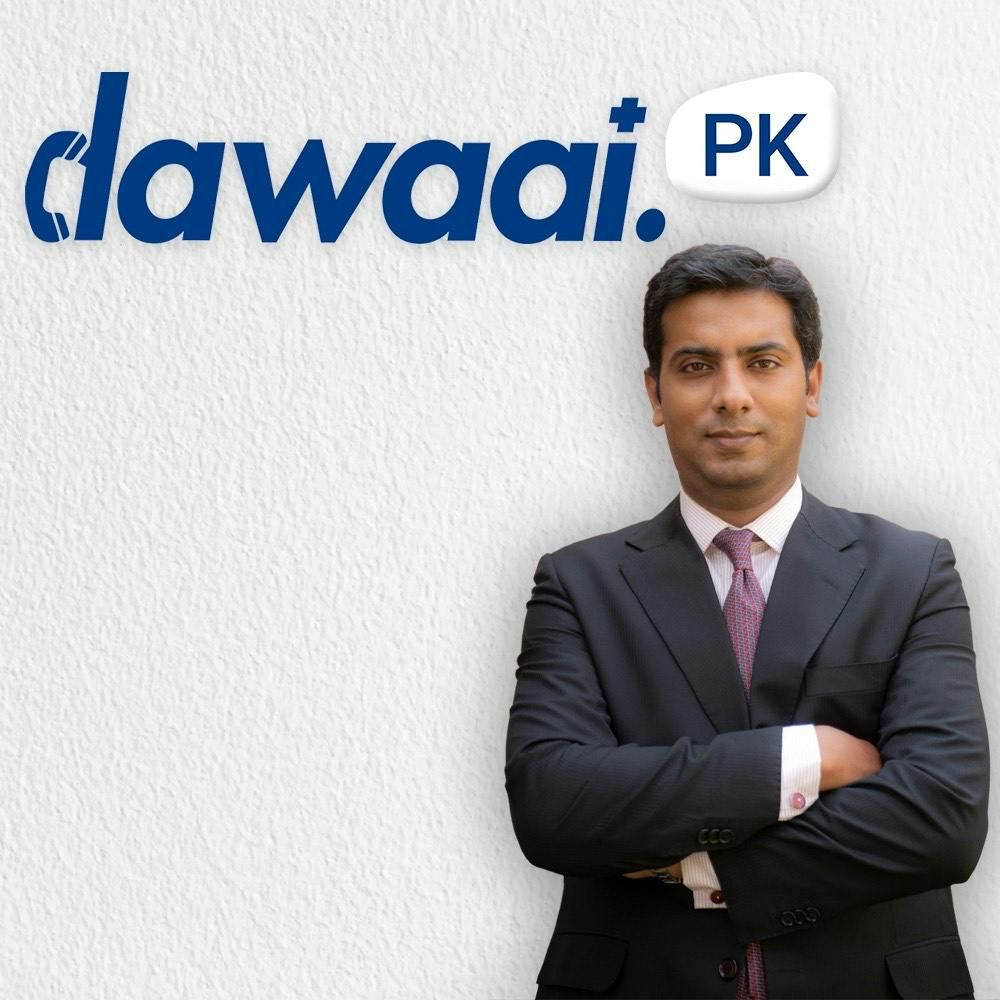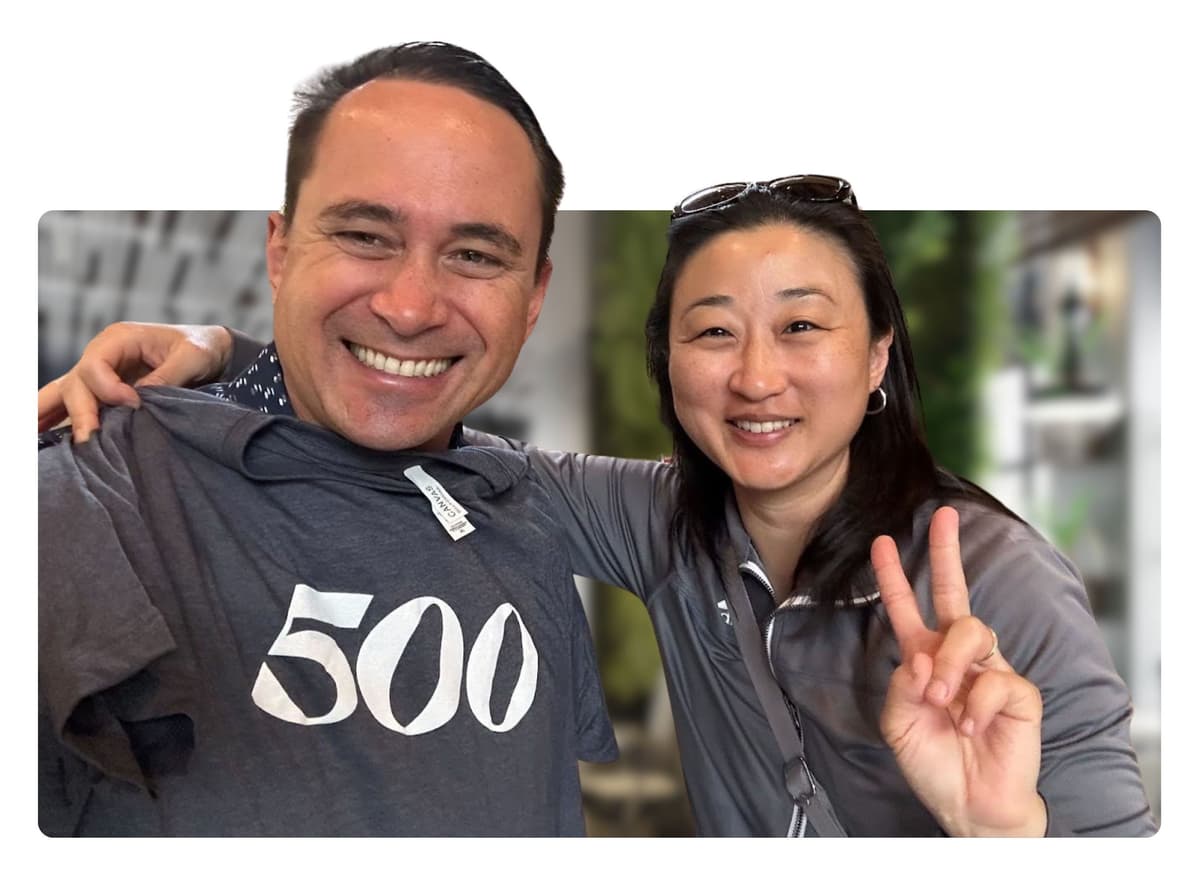In this episode of Rise of the Next, Furquan talks about how his online pharmacy, Dawaai, is modernizing a highly fragmented market.
2022.02.04

500 Global Team

Picture courtesy of Dawaai
Furquan Kidwai left his career as a banker in London and moved to Karachi to found Dawaai in 2013, an online pharmacy aiming to modernize a highly fragmented market made up of small independent pharmacies. It’s a model, he says, that has a lot in common with PillPack.
In this episode of Rise of the Next, Furquan talks about wading into a market where an estimated 40% of drugs are fake, inventory issues abound, and patient trust is low. It’s one of many opportunities for founders to transform industries, he believes, in Pakistan.
Subscribe here to episodes of Rise of the Next on major streaming platforms.
TRANSCRIPT
Shereen Abdulla
Furquan, thank you very much for being on Rise of the Next.
Furquan Kidwai
My pleasure, thank you for having me.
FURQUAN’S BACKGROUND
Shereen Abdulla
Absolutely. Let’s start off by sharing with the audience why’d you leave a career in banking in the UK to move to Pakistan to found Dawaai?
Furquan Kidwai
Two main reasons — I think, Pakistan, back in the day, was not the hottest of markets, and I thought it is a very big market with not much focus of the entrepreneurs community, or even the investors communities. And I understood the market, I am from Pakistan, I grew up here, so it made sense for me to bring in my global experience, global perspective, and what I’ve seen outside working out, to Pakistan. And, in fact, I was the first to second entrepreneur in the country to get into this space and build something out. So that was primarily the driving factor. It’s a large market — 200 million people, fast-growing middle class, a very, very fast-growing broadband penetration, and, more importantly, very, very major problems which are in your face and no one was tackling them. Like counterfeiting medicines and accessibility of medicines — I think these are the things we take for granted back in the West, but here no one was doing anything about it.
ABOUT DAWAAI
Shereen Abdulla
Furquan, do you mind explaining to the audience what does Dawaai do?
Furquan Kidwai
Sure. So, Dawaai’s essentially an online pharmacy. We deliver medicines at doorsteps, that’s essentially what we do. We are a platform, which connects manufacturers directly with the consumers. Why are we doing that? To solve two main problems. A, Pakistan has a very broken fragmented pharmaceutical supply chain, which leads to counterfeiting being interjected. So, 30-40% of the market is expected, or assumed, to be counterfeit and patients’ trust is very low. So, by building a platform by connecting directly the source to the end consumer, we are eliminating the counterfeiting thing. So that’s why — one of the keys is we are doing this. Secondly, the market is one of the very few branded generics markets in the world. So that means for every paracetamol, there are about 10 brands of paracetamol being sold and patients are completely unaware of what to choose when they can actually save as much as 70% on the drugs, one. And B, because doctors are writing the name of a brand as a generic, a patient visiting a small mom-and-pop pharmacy is not necessarily going to have the prescribed brand available because those guys are keeping on average 200 SKUs when the market has about 20,000 SKUs. So the patients’ experience, as a result, is really bad.
We did a survey initially and for a normal diabetic patient to get their prescriptions fulfilled, they need to go at least to two or three pharmacies to fulfill their diabetes prescription, which is unheard of anywhere in a normal market. So, what we have done, we built a platform where it’s a one-stop-shop. Patients can come to Dawaai and get all their prescriptions fulfilled and they can be absolutely sure about the source of this prescription, which is directly the manufacturers. So, eliminating counterfeiting and having all availability under one roof, that is the purpose of building Dawaai.
DAWAAI’S CUSTOMERS
Shereen Abdulla
Who’s your customer?
Farquan Kidwai
So, intrinsically, it suits chronic patients who are chronically ill, have diabetes, or have cancer, have hypertension, have arthritis, have neurological diseases — those are the customers who need their prescriptions fulfilled on a regular basis. So that’s one thing, and that has been our historical base of late when we go into quick delivery. That means we start delivering orders within one hour/ two hours, depending on the location. And people became aware of the counterfeiting issue in the market, and the trust eroded, and we built a brand around trust. A lot of quality-minded customers started coming to our platform because they were not chronically ill, they had acute medication needs, like antibiotics, stomach bugs, the normal, and they knew it could be available within an hour or so and at the right price, and more importantly, to the correct quality, the actual quality. So that customer base grew dramatically over the last couple of years, who buy from us. And then there’s, a third base who needs vitamins, supplements — they need quite regularly — and they need to go to multiple pharmacies to get those items done as well. We are a one-stop shop, so they start ordering. As a result, because of various service levels, we start from chronic, then acute people start coming up, and we did quick deliveries. And then, because of a large range, the OTC and vitamins and supplements users started using us as well, because those are not readily available everywhere else. So that’s how the customer base essentially grew to the entire pharmaceutical spectrum, per se.
Shereen Abdulla
Interesting. Roughly, I would say, then, three different areas of opportunity that are clearly carvable.
Furquan Kidwai
Correct. I think if you look at the general pharma market in Pakistan, it is dominated by people who are acute, who are chronically ill. If you look at the top 10 medicines, you can actually see which categories they belong to — top 50 medicines, sorry. And those are within the acute and the chronic, and particularly diabetes, and hypertension, and antibiotics. These are three main categories.
THE PHARMA LANDSCAPE IN PAKISTAN
Shereen Abdulla
You mentioned, earlier in the discussion, that pre-Dawaai, the way people would go about getting their drugs, prescription, or otherwise, was by visiting these mom-and-pop stores. Roughly how accessible are small pharmacies in Pakistan, and do you happen to have a number of how many small pharmacies there are?
Furquan Kidwai
So it’s a 99% fragmented market, there are about 30 to 40,000 small mom-and-pop pharmacies across the country where people can go and buy. These are individually run, not well-stocked at all because, as I mentioned, they (on average) keep about 20,000 odd SKUs based on what they hope is going to sell, whereas the registered SKU base in the country is 20,000. So that’s a fragmentation in the market. And then these are small players who are not necessarily covered by the distributors, and whatnot, so they have to rely on going to the wholesale market, which could be 30/40/50 kilometers away to go and procure the medicines. And thirdly speaking, they don’t have enough working capital to buy large chunks of stocks, either, so they have to have this daily visit, or every other day, to get their stocks fulfilled. And, combined with all these things, the customer/ the patient experience is very poor because of being out of stock and the medicines not being authentic in many cases. So, generally, it’s not the most convenient of things for patients to do, and those are the main pain points, which you’re trying to solve.
ADOPTION OF DIGITAL PAYMENTS IN PAKISTAN
Shereen Abdulla
On that note, how prevalent are online payments in Pakistan? Because I’m sure that people of the age bracket, or let’s say demographic, that you mentioned spend with cash.
Furquan Kidwai
Yeah, I think the online payments are picking up with wallets, with cards, banks — the issuing banks are really working hard to make sure the card usage goes up by incentivizing and whatnot. And we were the first one, I think four years ago, to launch any bank partnership in the entire e-commerce space in Pakistan. And since then, it has really gone further up, but it is still majorly a cash-on-delivery market. But I don’t think that is that much of an issue, contrary to what most people try to make an issue out of it. I think it’s making an issue out of a nonissue. If we look at Russia, as an example, Russia is a 70-80% cash-on-delivery market. Cash-on-delivery is not a massive issue, at least the way I look at it, in my opinion. We run our own last mile in many cities, so we manage the cash, which is fine by us. And what’s more important, it’s what the customer wants. We are not in the payment space — if the customer’s preference is to pay by cash, we are happy to take cash. If the preference is to pay by card, we’re happy to take a card. We take all sorts of payment mechanisms.
SUPPLY CHAIN CHALLENGES
Shereen Abdulla
Interesting. So, I’m curious, in your business, what challenges do you face?
Furquan Kidwai
Oh, many! It’s a supply chain business, so operating at 20,000 odd SKUs at a very large volume base, which is growing so fast, I think that is unprecedented in the market. And I think that’s unprecedented from a suppliers’ perspective as well. The supply chain is not used to coping with this kind of volume put up. One player coming in, doing that much volume. One player asking for that big of range of medications, including tail items, which are hardly sold. So, I think our business’s biggest problem is actually supply chain aggregation because it’s very complicated, it’s fragmented, it’s complicated, and it’s distributed. We are, essentially, across multiple warehouses across the country. We are actually aggregating this supply chain, which has already been very complex, but we are aggregating in a distributed fashion. So it’s more of an oxymoron to say, but we are aggregating across different cities, which is the biggest challenge for us, internally, from a technological perspective. From the forecasts and business perspective, what to keep/ what not to keep, that mix. And thirdly, from a supplier’s perspective, how to bring them all onboard under one platform. And as we are growing at 20-30% month-on-month and we are building the infrastructure, which takes time, that’s a plus to the business, in a way. So we are building the first-of-its-kind pharmaceutical, logistics infrastructure, including coaching water, and whatnot, at a very large scale. Those are the real challenges to build the business, because this can’t be done. There’s no magic wand to do it overnight.
Shereen Abdulla
And, globally, I know that there have been huge constraints when it comes to supply chain because of Covid-19. Have you seen that, therefore, being more of a challenge?
Furquan Kidwai
It has been a challenge because Pakistan’s pharma market depends on the imported raw material and a lot of important medicines. So within Covid, supply chain has been a massive issue, there has been a shortage of products, while demand has really gone through the roof. The supply hasn’t really kept up, and we, being the largest player in that space, we feel a lot of heat because customers face us. Any shortage is taken as a shortage on our part when actually the shortage is on the manufacturers’ part because of supply chain disruptions. So there’s been a lot of issues around supply chain, but those are getting resolved. And of course, what happened — the events which led to this are unprecedented, no one was ready for that, so I think it’s no one’s to blame. But yeah, this has been a massive challenge.
REGULATORY CHALLENGES
Shereen Abdulla
Now, what about regulation? Being in the health industry, regulation is, I’m sure it’s something that you need to work with. I’m curious, what are the key regulations you would need to work around, and have any of the regulations ever become a challenge?
Furquan Kidwai
I think the regulations are pretty clear in Pakistan. I think in most countries — even PillPack in the US, they have come back with regulations, essentially building out the infrastructure, which has been fully regulated, fully compliant. Same with us, we are complying with the Drug Act of 1970 with an amendment in 2001. In fact, we claim that we are the only pharmacy business in the country which has 110% compliant. At best anyone has 50% compliance. We reject orders if they are not having a valid prescription, and the cold chain — the temperature, on average, in the summer is 35 degrees. Ambient temperature for a product should not be more than 25 degrees. So our warehouse, that’s an additional cost to us, that’s an overhead, but our compliance is just up there. We have 60 people, out of a 600 people team, which are just in compliance functions spread across the organization. I don’t think that is actually a problem for us. If anything, that’s an advantage for us.
DAWAAI MODEL VS. PILLPACK’S MODEL
Shereen Abdulla
Now, you mentioned PillPack, and we have actually over the course of this discussion mentioned Amazon quite a few times and I know that PillPack was acquired by Amazon a few years ago — I’m curious, how does Dawaai’s model compare to PillPack’s?
Furquan Kidwai
It’s a very similar model. PillPack builds infrastructure and dispenses medication, that’s what we do. Of course, I think the differences are the pharmaceutical market structure being very different in the US versus in Pakistan, or this part of the world. In the US, the market is more doctor-dominated, that means the prescriptions are written by the doctors and they are from the doctors’ system. They go to your preferred pharmacy based on the insurance preferences, and that pharmacy dispenses. So any pharmacy player has to have a doctor’s integration, whereas in Pakistan, or this part of the world, there’s been a disconnect. A doctor writes a prescription on a piece of paper and hands it over to the patient, and it’s the patient’s choice which pharmacy they want to go to, and it’s a 100% out-of-pocket market anyway. So it’s more of a direct-to-consumer business to acquire patients rather than a wired doctor, which is in the US.
So those are the nuances of the market structure, but the business model is a full stack model, very similar to PillPack, very similar to PharmEasy in India, very similar to PingAn in China. Most of the healthcare business, I think globally, despite all the talk about per platform and whatnot, they have, in one form or the other, the physical layer with them. It’s because of the regulatory perspective, because of the very specific nature, and also more from a trust perspective — digital-only with no physical level whatsoever does not work. And we have tried that, it either doesn’t work from an economic standpoint, or from a regulatory standpoint, or from a quality standpoint, because you control none of these in a pure digital place. And that’s why, globally, all the digital players have owned a significant portion of the physical layer in whichever vertical they operate in. The only player, which is Zocdoc in the US, did not own, but that has its own issues.
DAWAAI’S EXPANSION PLANS
Shereen Abdulla
Now, I know that Dawaai is actually planning on expanding, or I believe has already begun expanding in some emerging markets — so I’m curious about a couple of things: firstly, which markets; and secondly, in expanding, would you adopt your model based on the local dynamics of where it is that you’re expanding to?
Furquan Kidwai
We are exploring, we have actually — will be announcing soon, I must not say which market we are going into. I think our expansion plans are going to go after markets that are similar in nature to ours, the regulatory framework is similar to ours because our product is tailor-made for that. So we are not going to go into a market which is drastically different to ours, with a customer behavior drastically different to ours, with regulations that are drastically different, because then the entire product map has to be revamped. That’s what we’re not going to do. But, of course, the nuances of the market have to be taken into account, the product modifications have had to have happened for a specific market. So that’s, essentially — those are tweaks rather than an entire revamp of the product. But again, our idea is to be in those markets that are similar to ours, in most aspects than otherwise.
THE STARTUP LANDSCAPE IN PAKISTAN
Shereen Abdulla
Furquan, closing question for you — how has the business environment in Pakistan, in general, changed over the years to make it a more conducive place for founders, like yourself, to come and open a startup?
Furquan Kidwai
I think it has become very, very conducive to do this thing, contrary to when I started. I think that’s primarily driven by the fact that there’s pent-up consumer demand. There’s been a very, very large uptake of mobile smartphones in the country. So there’s an 80% mobile phone penetration, half of which is smart, mobile phones. Broadband, mobile broadband has grown, I think, 3x year-on-year. There’s been a 25x growth in the last six years on mobile broadband.
So, the consumer — I think, being a young population, the user behavior is changing consumers. There’s a pent-up demand for things to happen differently. I think, it’s a wave and whether I do it or not, I think that wave is coming from the demand side. So you have to be in the middle of it to do so.
And then, of course, the government and the wider regulatory environment is very, very conducive for this because the policymakers are realizing that this is the need of the hour. The population needs it, so we can’t be the blockage. I think that’s why I’m where I am today — because they are paying enough attention to the space to invite people to meet us at the highest level of the government, because this has become the big agenda. So, as a result of all these factors, Pakistan has become a very, very hot place recently for entrepreneurs to actually operate. There are many low-hanging fruits to go after. Capital is, now, flowing in a lot.
And I think it’s still part of a very relatively cheaper market, compared to its regional counterparts. The opportunity right now is to get in before it gets too late, too expensive for many investors to get it. And same for entrepreneurs, this is the time to come and start something and solve real problems. Don’t become an entrepreneur for the sake of being an entrepreneur — it is a hard journey, as you would appreciate. But there are many problems around us, which needs to be solved using technology and that gives enough opportunities for entrepreneurs to operate.
Shereen Abdulla
For sure. Here’s the next wave of entrepreneurs. Furquan, thank you very much for your time. It was a pleasure to meet you and it was a pleasure to learn more about Dawaai and the opportunity that it’s going after in Pakistan.
Furquan Kidwai
Thank you, Shereen. Great talking to you. Thank you for having me over.
THIS PODCAST IS INTENDED SOLELY FOR GENERAL INFORMATIONAL OR EDUCATIONAL PURPOSES ONLY. UNDER NO CIRCUMSTANCES SHOULD ANY CONTENT PROVIDED AS PART OF ANY SUCH PROGRAMS, SERVICES OR EVENTS BE CONSTRUED AS INVESTMENT, LEGAL, TAX OR ACCOUNTING ADVICE BY 500 STARTUPS MANAGEMENT COMPANY, L.L.C. OR ANY OF ITS AFFILIATES (“500 GLOBAL”). 500 GLOBAL MAKES NO REPRESENTATION AS TO THE ACCURACY OR INFORMATION IN THIS PODCAST AND WHILE REASONABLE STEPS HAVE BEEN TAKEN TO ENSURE THAT THE INFORMATION HEREIN IS ACCURATE AND UP-TO-DATE, NO LIABILITY CAN BE ACCEPTED FOR ANY ERROR OR OMISSIONS AND 500 GLOBAL ACCEPTS NO RESPONSIBILITY FOR ANY LOSS WHICH MAY ARISE FROM RELIANCE ON THE INFORMATION IN THIS PODCAST. UNDER NO CIRCUMSTANCES SHOULD ANY INFORMATION OR CONTENT IN THIS PODCAST, BE CONSIDERED AS AN OFFER TO SELL OR SOLICITATION OF INTEREST TO PURCHASE ANY SECURITIES ADVISED BY 500 GLOBAL OR ANY OF ITS AFFILIATES OR REPRESENTATIVES. FURTHER, NO CONTENT OR INFORMATION IN THIS PODCAST IS INTENDED AS AN OFFER TO PROVIDE ANY INVESTMENT ADVISORY SERVICE WITH REGARD TO SECURITIES BY 500 GLOBAL. UNDER NO CIRCUMSTANCES SHOULD ANYTHING HEREIN BE CONSTRUED AS FUND MARKETING MATERIALS BY PROSPECTIVE INVESTORS CONSIDERING AN INVESTMENT INTO ANY 500 GLOBAL INVESTMENT FUND. UNDER NO CIRCUMSTANCES SHOULD ANY STATISTICS, QUOTATIONS OR OTHER CONTENT BE INTERPRETED AS TESTIMONIALS OR ENDORSEMENT OF THE INVESTMENT PERFORMANCE OF ANY 500 GLOBAL FUND BY A PROSPECTIVE INVESTOR CONSIDERING AN INVESTMENT INTO ANY 500 GLOBAL FUND. THIS PODCAST MAY CONTAIN FORWARD-LOOKING STATEMENTS WHICH INVOLVE RISKS AND UNCERTAINTIES, AND ACTUAL RESULTS MAY DIFFER MATERIALLY FROM ANY EXPECTATIONS, PROJECTIONS OR PREDICTIONS MADE OR IMPLICATED IN SUCH FORWARD-LOOKING STATEMENTS. THE PODCAST INCLUDES CONTENT DELIVERED BY AN INDEPENDENT THIRD PARTY THAT IS NOT RELATED TO OR CONTROLLED BY 500 GLOBAL. ALL VIEWS AND OPINIONS PRESENTED IN THE PODCAST BY SUCH THIRD PARTY ARE THEIR OWN VIEWS AND OPINIONS AND DO NOT REPRESENT THOSE OF 500 GLOBAL. 500 GLOBAL MAKES NO REPRESENTATIONS AS TO OR GUARANTEES OF SPECIFIC OUTCOMES FROM ATTENDING OR RELYING ON THE CONTENTS OF THE PODCAST.











